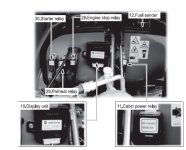tkh159
Bronze Member
Good fully charged Battery, if that is the static battery voltage. Charging voltage should be about 14.1 or so after a startup, slowly tapering off as the battery comes to a full charge. Usually around 13.8 to 13.9 .
In cold weather hitting the glow plugs will drag it down to 10.something depending on how cold and how good your battery is. But as soon as it starts it should go to about 14.1 or 14.2 or so
Is it a safe assumption if the battery is charging around 14 volt +/- that the alternator is functioning properly?


